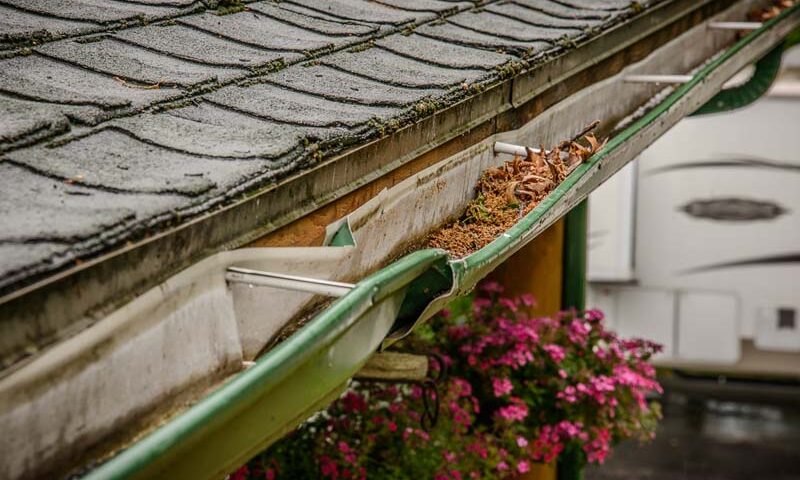Gutters are an essential part of protecting your home from leaks, foundation erosion and yard damage, but they’re not indestructible. Depending on how old your home is, and the type of gutters you have, you will have to replace your gutters every once in a while. How frequently you need to replace them and when you need to replace gutters are dependent on a few factors. Unsure if your gutters are causing damage to your home and need to be replaced? Read on below for signs that you may need new gutters and when the best time is to replace them!
1. Visible Cracks, Gaps, or Seam Separation
The most obvious reason your home may be ready for a new gutter system is if you notice visible cracking, gaps, and separation.
Cracks and Fractures
If you notice gaps between your gutters or cracks and fractures on your gutters, you have an issue that should be solved immediately. Not only can water seep through these cracks, but they are often the sign of more extensive damage – like additional small tears and breaks. Of course, you can determine if there is more extensive damage by monitoring your gutters during the rain. If there is a multitude of cracks, you will notice them as the rain seeps through them. Even better, hire a professional gutter installation company for their expert opinion.
Seam Separation
Although we’ve mentioned gutter breakage, there is a different type of crack that may start to form in your gutter system – seam separation. Gutter seams are the weakest portion of any gutter system and when not installed correctly, gutters can quickly separate at the seams. Gutter seams can sometimes be mended, but oftentimes a single seam separation is just a sign of further damage to come. To avoid seam separation in the future, consider installing a seamless gutter system or ensuring your gutter installer is skilled and well-qualified.
Your gutters should be seamless and free from gaps and cracks, and any existing gaps and fractures should be immediately remedied as they can grow much larger in size, creating even greater problems for your gutter system and your home. Even better, hire a professional gutter installation company for their expert opinion.
2. Sagging Gutters or Standing Water
Gutters are slightly slopped so that water flows towards the downspouts. If you notice standing water or sagging gutters your gutters might need fixed.
Sagging Gutters
Not only can sagging gutters be a sign of excessive standing water, but sagging can also be a sign that your gutters’ brackets may be loose. While brackets can sometimes be repaired or replaced, when left untreated, sagging gutters can cause further damage (sometimes to the home’s exterior) and need to be replaced.
Standing Water
If you see standing water in your gutters, something is definitely off. Gutters are supposed to allow water to flow freely so the water can be properly disposed of. If there is standing water, there is some sort of blockage. Unfortunately, gutter blockages can be difficult to find and replacement gutters frequently need to be purchased to replace the old gutter with the blockages.
Sagging gutters and standing water our signs your gutters need to be repaired ASAP. Consider contacting an expert gutter contractor to help unblock or tighten up your gutters.
3. Rust
If you have metal gutters, they can be prone to rust. As you may be familiar with, rust can cause corrosion, and if your gutters corrode, they can no longer hold water. When you see major rust you should install new gutters before the rusted metal completely breaks off and rain water drops onto your home or yard.
4. Water Damage & Mold
Seeing mold or paint peeling in your basement or on the exterior of your home? It could be caused by a faulty gutter systems carrying moisture to the wrong areas.
Home Discoloration & Mold/Mildew
If you start to notice discoloration on either the inside or the outside of your house, you may have a moisture problem caused by broken gutters. If your gutters aren’t doing their job, the rain that should be carted away by your gutter system will instead hit the side of your house. Repeated exposure to moisture can quickly cause discoloration on the side of your home and cause mildew and mold to form on both the interior and exterior. Not only are discoloration, mold, and mildew unsightly, but they can be harmful to your health and your home’s integrity.
Peeling Paint
Another sign of excess water around your house is peeling paint. Paint will start to lift and peel from your home’s exterior when exposed to repeated excess water. If you’re noticing peeling paint on a particular place in your home, look up and examine the section of gutters above it. Besides peeling paint on the exterior of your home, as another sign of a broken gutter, you may start to notice paint peeling on your gutters as well.
If you see mold or paint peeling you should immediately get your gutters inspected, as broken gutter systems are one of the most common causes of that excess moisture.
5. Soil Erosion and Foundation Issues
With soil erosion and excess moisture in your yard comes foundation issues.
Soil Erosion
As we mentioned above, protecting your soil is one of your gutter system’s main jobs, so if you’re seeing thin or eroded soil, it’s almost always caused by the lack of gutters or a broken gutter system. Not only is soil erosion bad for your yard, but it can also lead to foundation issues.
Foundation Issues
With soil erosion and excess moisture in your yard comes foundation issues. When water gets absorbed near the foundation for long periods of time, it can cause the foundation to shift and crack which can obviously cause major damage to your home and is much more expensive to repair than a broken gutter.
When’s the Best Time to Replace Your Gutters?
Best time to replace gutters: spring or early fall. Why? Because the weather is mild and you can catch issues before heavy rain or freezing temps hit. You’ll also avoid the winter rush when contractors are booked out or working in icy conditions.
Here’s how to know when to pull the trigger:
- Right after a rainy season: If you’ve seen leaks, overflow or water pooling around your foundation during storms, it’s a sign your gutters couldn’t keep up.
- Before winter: Replacing damaged gutters before freezing temps hit helps avoid ice dams and water damage.
- When you’re doing exterior work: If you’re painting your house, getting a new roof or improving landscaping, it’s smart to do the gutters at the same time.
- When repairs keep piling up: Constant fixes are a money pit. At some point it’s more cost effective to just install new gutters.
Timing your gutter replacement can prevent bigger issues down the line – like foundation cracks, mold problems and ruined landscaping. Water can seep through those cracks but they’re often a sign of more damage – like small tears and breaks. Consider calling a gutter expert to help unblock or tighten up your gutters.
When to Consult a Professional
Is it time for a new gutter system for your home? While we certainly hope our above list has been a helpful way to narrow down if you have an issue with broken gutters, the best way to know for sure is to contact our experts at New Vision Exteriors. Give us a call today for a free consultation!

